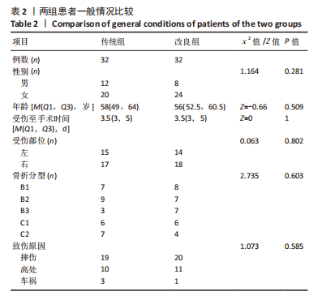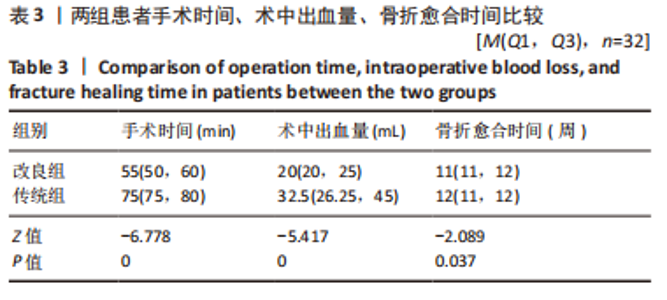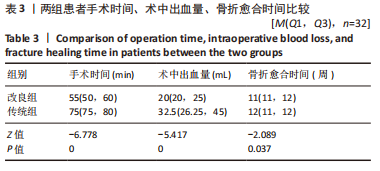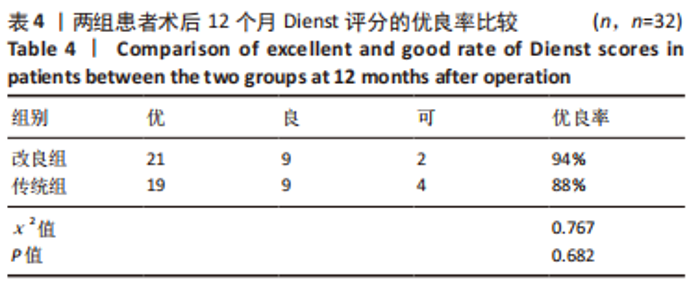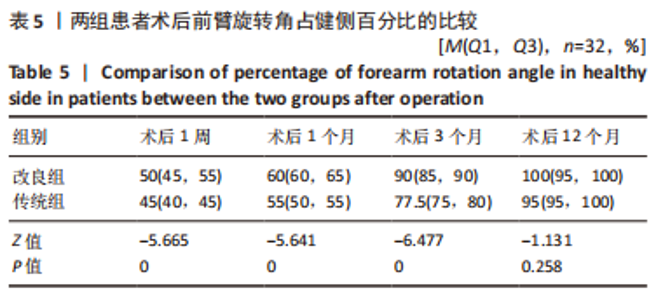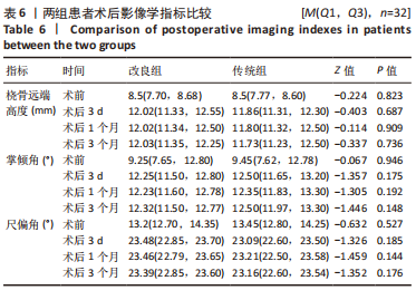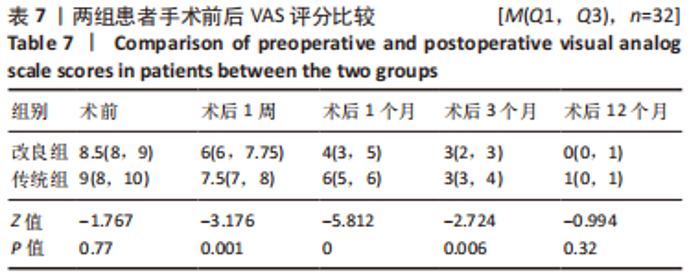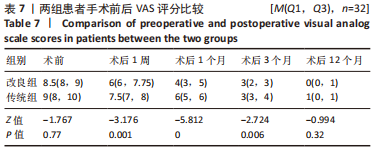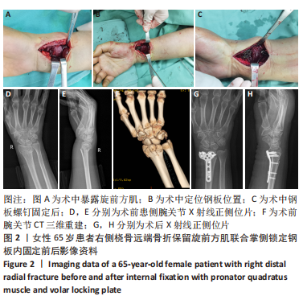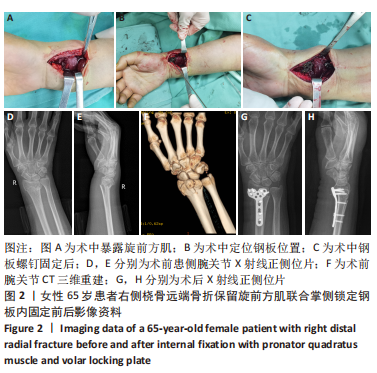Chinese Journal of Tissue Engineering Research ›› 2023, Vol. 27 ›› Issue (31): 4959-4964.doi: 10.12307/2023.678
Previous Articles Next Articles
Preservation of pronator quadratus muscle combined with volar locking plate in the treatment of distal radial fractures
Huang Xiaoxia1, 2, 3, Jia Qiyu2, Erxat•Kerem4, Peng Cong2, Kong Weiqi2, Teng Yong3, Zhao Yan2
- 1Graduate School of Xinjiang Medical University, Urumqi 830011, Xinjiang Uygur Autonomous Region, China; 2Department of Orthopedics, First Affiliated Hospital of Xinjiang Medical University, Urumqi 830011, Xinjiang Uygur Autonomous Region, China; 3Department of Spine Surgery, General Hospital of Xinjiang Military Region of the Chinese People’s Liberation Army, PLA Orthopedic Center, Urumqi 830099, Xinjiang Uygur Autonomous Region, China; 4Department of Orthopedics, Seventh Affiliated Hospital of Xinjiang Medical University, Urumqi 830054, Xinjiang Uygur Autonomous Region, China
-
Received:2022-08-30Accepted:2022-09-28Online:2023-11-08Published:2023-01-31 -
Contact:Teng Yong, Chief physician, Master’s supervisor, Doctoral supervisor, Department of Spine Surgery, General Hospital of Xinjiang Military Region of the Chinese People’s Liberation Army, PLA Orthopedic Center, Urumqi 830099, Xinjiang Uygur Autonomous Region, China Zhao Yan, Chief physician, Master’s supervisor, Department of Orthopedics, First Affiliated Hospital of Xinjiang Medical University, Urumqi 830011, Xinjiang Uygur Autonomous Region, China -
About author:Huang Xiaoxia, Doctoral candidate, Graduate School of Xinjiang Medical University, Urumqi 830011, Xinjiang Uygur Autonomous Region, China; Department of Orthopedics, First Affiliated Hospital of Xinjiang Medical University, Urumqi 830011, Xinjiang Uygur Autonomous Region, China; Department of Spine Surgery, General Hospital of Xinjiang Military Region of the Chinese People’s Liberation Army, PLA Orthopedic Center, Urumqi 830099, Xinjiang Uygur Autonomous Region, China -
Supported by:Special Plan for Regional Collaborative Innovation in Xinjiang Uygur Autonomous Region, No. 2019E0277 (to TY)
CLC Number:
Cite this article
Huang Xiaoxia, Jia Qiyu, Erxat•Kerem, Peng Cong, Kong Weiqi, Teng Yong, Zhao Yan. Preservation of pronator quadratus muscle combined with volar locking plate in the treatment of distal radial fractures[J]. Chinese Journal of Tissue Engineering Research, 2023, 27(31): 4959-4964.
share this article
Add to citation manager EndNote|Reference Manager|ProCite|BibTeX|RefWorks
| [1] 黄晓夏,伊尔夏提·克力木,彭聪,等. 改良Henry入路治疗桡骨远端AOB型骨折的疗效分析[J]. 中华骨与关节外科杂志,2022,15(1): 43-48. [2] CHUNG KC, SPILSON SV. The frequency and epidemiology of hand and forearm fractures in the United States. J Hand Surg Am. 2001;26(5): 908-915. [3] SMITH DW, HENRY MH. Volar fixed-angle plating of the distal radius. J Am Acad Orthop Surg. 2005;13(1):28-36. [4] QUADLBAUER S, PEZZEI C, JURKOWITSCH J, et al. Early complications and radiological outcome after distal radius fractures stabilized by volar angular stable locking plate. Arch Orthop Trauma Surg. 2018;138(12): 1773-1782. [5] PLANT CE, PARSONS NR, COSTA ML. Do radiological and functional outcomes correlate for fractures of the distal radius?Bone Joint J. 2017;99(3):376-382. [6] JOHNSON RK, SHREWSBURY MM. The pronator quadratus in motions and in stabilization of the radius and ulna at the distal radioulnar joint. J Hand Surg Am. 1976;1(3):205-209. [7] ARMANGIL M, BEZIRGAN U, BAŞARıR K, et al. The pronator quadratus muscle after plating of distal radius fractures: is the muscle still working? Eur J Orthop Surg Traumatol. 2014;24(3):335-339. [8] 钱忠卫,张巧云. 旋前方肌对前臂旋前功能的影响[J]. 中华手外科杂志,2021,37(4):255-257. [9] CHLOROS GD, PAPADONIKOLAKIS A, GINN S, et al. Pronator quadratus space and compartment syndrome after low-energy fracture of the distal radius: a case report. J Surg Orthop Adv. 2008 Summer;17(2):102-106. [10] BERGLUND LM, MESSER TM. Complications of volar plate fixation for managing distal radius fractures. J Am Acad Orthop Surg. 2009;17(6): 369-377. [11] HERSHMAN SH, IMMERMAN I, BECHTEL C, et al. The effects of pronator quadratus repair on outcomes after volar plating of distal radius fractures. J Orthop Trauma. 2013;27(3):130-133. [12] MULDERS MAM, WALENKAMP MMJ, BOS FJME, et al. Repair of the pronator quadratus after volar plate fixation in distal radius fractures: a systematic review. Strategies Trauma Limb Reconstr. 2017;12(3):181-188. [13] KIM JK, PARK JS, SHIN SJ,et al. The effect of brachioradialis release during distal radius fracture fixation on elbow flexion strength and wrist function. J Hand Surg Am. 2014;39(11):2246-2250. [14] GOORENS CK, DE KEYZER PB, VAN ROYEN K,et al. Pronator quadratus repair after volar plate fixation in distal radial fractures: evaluation of the clinical and functional outcome and of the protective role on the flexor tendons-a randomized controlled study. Eur J Orthop Surg Traumatol. 2021;31(3):541-548. [15] FEENEY MS, WENTORF F, PUTNAM MD. Simulation of altered excursion of the pronator quadratus. J Wrist Surg. 2014;3(3):198-202. [16] NHO JH, GONG HS, SONG CH, et al. Examination of the pronator quadratus muscle during hardware removal procedures after volar plating for distal radius fractures. Clin Orthop Surg. 2014;6(3):267-272. [17] SHI F, REN L. Is pronator quadratus repair necessary to improve outcomes after volar plate fixation of distal radius fractures? A systematic review and meta-analysis. Orthop Traumatol Surg Res. 2020; 106(8):1627-1635. [18] LU CK, LIU WC, CHANG CC,et al. A systematic review and meta-analysis of the pronator quadratus repair following volar plating of distal radius fractures. J Orthop Surg Res. 2020;15(1):419. [19] BERTELLI JA, GHIZONI MF. Reconstruction of C5 and C6 brachial plexus avulsion injury by multiple nerve transfers: spinal accessory to suprascapular, ulnar fascicles to biceps branch, and triceps long or lateral head branch to axillary nerve. J Hand Surg Am. 2004;29(1):131-139. [20] SWIGART CR, BADON MA, BRUEGEL VL, et al. Assessment of pronator quadratus repair integrity following volar plate fixation for distal radius fractures: a prospective clinical cohort study. J Hand Surg Am. 2012;37(9):1868-1873. [21] HOHENDORFF B, UNGLAUB F, SPIES CK, et al. Refixierung des Musculus pronator quadratus mit einem Teil des M.-brachioradialis-Ansatzes bei der palmaren Plattenosteosynthese einer distalen Radiusfraktur [Repair of the pronator quadratus muscle with a part of the brachioradialis muscle insertion in volar plate fixation of a distal radius fracture]. Oper Orthop Traumatol. 2020;32(1):82-86. [22] KASHIR A, O’DONNELL T. A Brachioradialis Splitting Approach Sparing the Pronator Quadratus for Volar Plating of the Distal Radius. Tech Hand Up Extrem Surg. 2015;19(4):176-181. [23] HEIDARI N, CLEMENT H, KOSUGE D,et al. Is sparing the pronator quadratus muscle possible in volar plating of the distal radius? J Hand Surg Eur Vol. 2012;37(5):402-406. [24] LIVERNEAUX PA. The minimally invasive approach for distal radius fractures and malunions. J Hand Surg Eur Vol. 2018;43(2):121-130. [25] REY PB, ROCHET S, LOISEL F, et al. Technical note: How to spare the pronator quadratus during MIPO of distal radius fractures by using a mini-volar plate. Chir Main. 2014;33(2):95-99. [26] SALGARELLO M, VISCONTI G, BARONE-ADESI L. Interlocking circumareolar suture with undyed polyamide thread: a personal experience. Aesthetic Plast Surg. 2013;37(5):1061-1062. [27] 王楠,杜国庆,蔡雨卫,等.桡骨远端骨折固定方法的研究进展[J].医学综述,2020,26(6):1131-1136. [28] 李彦宇,赵岩,李孟杰.改良Henry入路治疗不稳定桡骨远端骨折疗效分析[J].中国骨与关节杂志,2020,9(9):654-660. [29] MIRARCHI AJ, NAZIR OF. Minimally Invasive Surgery: Is There a Role in Distal Radius Fracture Management? Curr Rev Musculoskelet Med. 2021;14(1):95-100. [30] HUANG HK, WANG JP, CHANG MC. Repair of Pronator Quadratus With Partial Muscle Split and Distal Transfer for Volar Plating of Distal Radius Fractures. J Hand Surg Am. 2017;42(11):935.e1-935.e5. [31] ARORA R, LUTZ M, HENNERBICHLER A, et al. Complications following internal fixation of unstable distal radius fracture with a palmar locking-plate. J Orthop Trauma. 2007;21(5):316-322. [32] DUNCAN SF, WEILAND AJ. Delayed rupture of the flexor pollicis longus tendon after routine volar placement of a T-plate on the distal radius. Am J Orthop (Belle Mead NJ). 2007;36(12):669-670. [33] Rampoldi M, Marsico S. Complications of volar plating of distal radius fractures. Acta Orthop Belg. 2007;73(6):714-719. [34] GRADL G, MIELSCH N, WENDT M, et al. Intramedullary nail versus volar plate fixation of extra-articular distal radius fractures. Two year results of a prospective randomized trial. Injury. 2014;45 Suppl 1:S3-8. [35] PIERRART J, TORDJMAN D, IKEUCHI N,et al. Lésions nerveuses associées aux fractures de l’extrémité distale du radius [Nerve injuries associated with distal radius fractures]. Hand Surg Rehabil. 2016;35S:S75-S79. [36] LIVERNEAUX P, ICHIHARA S, FACCA S,et al. Résultats de l’ostéosynthèse par plaque antérieure et abord mini-invasif (MIPO) des fractures de l’extrémité distale du radius : mise au point [Outcomes of minimally invasive plate osteosynthesis (MIPO) with volar locking plates in distal radius fractures: A review]. Hand Surg Rehabil. 2016;35S:S80-S85. [37] SONNTAG J, HERN J, WOYTHAL L, et al. The Pronator Quadratus Muscle After Volar Plating: Ultrasound Evaluation of Anatomical Changes Correlated to Patient-Reported Clinical Outcome. Hand (N Y). 2021;16(1):32-37. [38] FANG K, LIN X, LIU X, et al. Do we need to suture the pronator quadratus muscle when we do open reduction and internal fixation for fracture of the distal radius. BMC Musculoskelet Disord. 2020; 21(1):453. [39] 闵捷, 郭雅娣, 廖晓辉,等. 保留旋前方肌桡骨远端骨折内固定术的解剖学及临床研究[J]. 中华创伤骨科杂志,2018,20(5):376-381. [40] OBERT L, LOISEL F, GASSE N, et al. Distal radius anatomy applied to the treatment of wrist fractures by plate: a review of recent literature. SICOT J. 2015;1:14. [41] AGNEW SP, LJUNGQUIST KL, HUANG JI. Danger zones for flexor tendons in volar plating of distal radius fractures. J Hand Surg Am. 2015;40(6): 1102-1105. [42] 朱宗东,廖锋,魏丹,等.充填植骨并部分保留旋前方肌掌侧锁定钢板内固定治疗桡骨远端C3.1、C3.2型骨折[J].中华手外科杂志, 2022,38(3):214-217. [43] HUANG X, JIA Q, LI H, et al. Evaluation of sparing the pronator quadratus for volar plating of distal radius fractures: a retrospective clinical study. BMC Musculoskelet Disord. 2022;23(1):625. [44] 彭聪,黄晓夏,孔维奇,等. 两种术中透视方法在桡骨远端骨折掌侧接骨板固定时的应用价值对比[J]. 中华骨与关节外科杂志,2022, 15(5):341-347. |
| [1] | Wu Taoguang, Nie Shaobo, Chen Hua, Zhu Zhengguo, Qi Lin, Tang Peifu. Biomechanical characteristics of a new multi-dimensional cross locking plate in the treatment of subtrochanteric nonunion [J]. Chinese Journal of Tissue Engineering Research, 2023, 27(9): 1330-1334. |
| [2] | Peng Zhixin, Yan Wengang, Wang Kun, Zhang Zhenjiang. Finite element analysis and structural optimization design of 3D printed forearm braces [J]. Chinese Journal of Tissue Engineering Research, 2023, 27(9): 1340-1345. |
| [3] | Zheng Hongrui, Zhang Wenjie, Wang Yunhua, He Bin, Shen Yajun, Fan Lei. Femoral neck system combined with platelet-rich plasma in the treatment of femoral neck fracture [J]. Chinese Journal of Tissue Engineering Research, 2023, 27(9): 1390-1395. |
| [4] | Zheng Bo, Zhang Xiuli, Zhou Hao, He Zebi, Zhou Jin, Zhou Weiyun, Li Peng. Arthroscopy-assisted locking hollow screw fixation and open reduction plate internal fixation in the treatment of Schatzker II-III tibial plateau fractures: early CT evaluation [J]. Chinese Journal of Tissue Engineering Research, 2023, 27(9): 1410-1416. |
| [5] | Sun Jiajia, Zhu Haidi, Lu Yun, Zhang Kai. Comparison of bone metabolism markers between type 2 diabetes mellitus and non-type 2 diabetes mellitus patients with hip fracture [J]. Chinese Journal of Tissue Engineering Research, 2023, 27(8): 1156-1160. |
| [6] | Zhao Wei, Feng Wei, Yang Tieyi, Ren Wei, Wang Yuxin, Lyu Huicheng, Chang Zhiqiang, Feng Xiaodong, Wang Ziheng, Guo Shibing. Antibiotic bone cement intramedullary nail prepared using 3D printed mold for the treatment of long bone infection in lower limbs [J]. Chinese Journal of Tissue Engineering Research, 2023, 27(7): 1023-1030. |
| [7] | Zhang Wei, Huang Zhichao, Zhao Ruifeng, Liang Huan, Ma Yufeng, Shen Yanguang, Zhong Honggang, Chen Zhaojun, Zhang Jichuan, Chen Weiheng. Efficacy of gutta-percha splint on a rabbit fracture model [J]. Chinese Journal of Tissue Engineering Research, 2023, 27(7): 1055-1061. |
| [8] | Huang Guijiang, Ji Yuwei, Zhao Xin, Yang Yi, Zhao Yulan, Wang Peijin, Tang Wei, Jiao Jianlin. Effect and mechanism of different administration routes of placenta-derived mesenchymal stem cells in the treatment of tree shrews with osteoporotic fracture [J]. Chinese Journal of Tissue Engineering Research, 2023, 27(6): 909-914. |
| [9] | Zhou Changjun, Long Shengli, Zou Wei, Xiao Jie, Long Hao, Feng Mingxing, Zhang Yang, Liu Jie, Zeng Zhongwei. Design and clinical application of coplanar screw guide for percutaneous pedicle screw in the treatment of thoracolumbar fracture [J]. Chinese Journal of Tissue Engineering Research, 2023, 27(4): 534-538. |
| [10] | Chen Lei, Jia Yanfei, Lyu Huicheng, Zhang Lifeng. Application of T-shaped plate for fractures involving the quadrilateral region of acetabulum [J]. Chinese Journal of Tissue Engineering Research, 2023, 27(4): 578-582. |
| [11] | Hong Xiao, Luo Hong, Yang Ruonan. Comparison of dynamic hip screw and anti-rotation screw internal fixation and femoral neck system internal fixation in the treatment of Garden II-IV femoral neck fracture [J]. Chinese Journal of Tissue Engineering Research, 2023, 27(4): 583-587. |
| [12] | Bao Kai, Song Wenhui, Liu Changwen, Liang Kaiheng, Wang Jiajia. Posterior single-segment pedicle screw fixation for unstable atlas fractures [J]. Chinese Journal of Tissue Engineering Research, 2023, 27(4): 594-599. |
| [13] | Sun Lingjuan, Song Xizheng, Li Daming, Han Zhenxue, Kang Yu, Xiang Hanrui, Sheng Kai. Percutaneous vertebroplasty under distraction with external spinal fixator for vertebral osteoporotic compression fractures with posterior wall damage [J]. Chinese Journal of Tissue Engineering Research, 2023, 27(31): 4954-4958. |
| [14] | Shi Guirong, Ren Bowen, Zhang Zhongbo, Wang Lisha, Zhang Qiwei, Shi Dongliang. Effect of Illicium henryi extract on angiogenesis in rats with osteoporotic fractures [J]. Chinese Journal of Tissue Engineering Research, 2023, 27(31): 5028-5034. |
| [15] | Tian Jiaqing, He Mincong, Wei Yurou, He Xianshun, Zhong Yuan, Jiang Yulai, Zhan Zhiwei, Wei Tengfei, He Xiaoming, Wei Qiushi. Distribution law and pathological characteristics of cystic degeneration in steroid-induced femoral head necrosis [J]. Chinese Journal of Tissue Engineering Research, 2023, 27(31): 4996-5001. |
| Viewed | ||||||
|
Full text |
|
|||||
|
Abstract |
|
|||||
